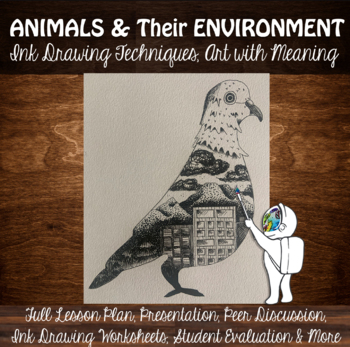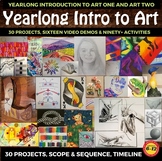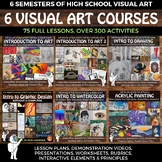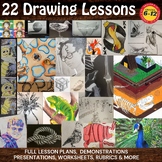Animals & Their Environment Ink Drawing Lesson: Middle or High School Drawing
- Zip
What educators are saying
Also included in
- Whether you're a new art teacher or a seasoned pro, our curriculum is designed to make teaching art easy and enjoyable. So why wait? Middle and High School Art students will love these unintimidating lessons that teach the basics of drawing, color mixing, and creativity! You will love the limited suPrice $125.00Original Price $224.00Save $99.00
- This visual art curriculm is packed with lifelong tools and includes everything you need to run your Middle or High School Introdcution to Art class. Highly organized, it includes a full Scope & Sequence charts, Visual Timelines, Engaging Lessons with Demonstration Videos, and Google-friendly PrPrice $195.00Original Price $385.49Save $190.49
- These visual art curriculum include full lessons, presentations, mini-lessons, worksheets, and sub-lessons for teaching 6 different high school visual art courses, including, Introduction to Art 1, Introduction to Art 2, Drawing, Watercolor, Acrylic, Graphic Design, and Digital Interactive Slides BuPrice $475.00Original Price $811.49Save $336.49
- Just the lessons, please! A variety of fun and engaging drawing lessons for Middle School Art or High School Art in a more affordable bundle without classroom management items like posters, worksheets, sub lessons, and interactive activities. This is a terrific option if you already have the supplemPrice $100.00Original Price $140.00Save $40.00
- This middle school drawing curriculum is designed to introduce middle school students to the fundamentals of art and foster their creativity through a variety of engaging projects. The course aims to develop students' skills in drawing using different mediums such as graphite, ink, and colored penciPrice $65.00Original Price $95.00Save $30.00
- This course welcomes all middle or high school visual art students, regardless of prior art experience, and provides a diverse range of engaging lessons introducing the captivating world of drawing and watercolor painting. Students are encouraged to explore personal style and creativity. Creative prPrice $85.00Original Price $122.00Save $37.00
Description
Teaching students to express themselves through their art is a surefire way to engage every student. In this ink drawing lesson, students make a connection between animals and their environment and in so doing, say something about themselves and their life. All while learning how to draw and shade in ink.
Student engagement and expression are two strengths that art teachers know well. Even so, with different experience/grade levels it can be hard in a secondary art room to keep everyone engaged! In this art project, students create art with meaning and learn about trending contemporary artists in the process, keeping them engaged and learning. Doing this kind of work leads to fantastic final pieces of art and great peer discussions!
As a lead-up to the lesson, students will complete a value in ink practice sheet using stippling, hatching, cross-hatching, and scribbling. Shade a pear using one of the techniques from the practice value scales. Learn about contemporary artist Alfred Basha and others. Conduct a peer discussion based on the artwork.
For the main drawing project, students will choose an animal, based on their personal experience, choose an environment to merge with the animal, and use inking techniques to effectively shade their ink animals. My students were enthralled, and their work was truly inspired.
Included:
- 5 Page lesson plan (Word & PDF) with National standards, big ideas, essential questions, goals, objectives, and detailed timeline with process notes
- 32 Page PowerPoint Presentation (pptx & PDF)
- Intro to Ink Value Scale and Shading Worksheets
- Peer Discussion Worksheet
- Project Checklist
- Demonstration video: How to draw on a grid
- Grid Practice Worksheet
- Student Self-Evaluation
- Thumbnail/Concept Worksheet
Materials:
- Micron Ink Pen: Sizes 03 and 05 (or other very fine-tipped drawing pens)
- Bristol Board (8’ x 10”) or Drawing Paper
- Pencil/Eraser
- Ruler: A graphic ruler works best
Key Learning:
- Draw and shade with ink
- Draw on a grid
- Express the connection between animals and their environment and in so doing, say something about ourselves and our life experiences.
- Learn about contemporary artists, including Alfred Basha
Vocabulary:
Line: An Element of Art. It is literally the extension of a dot. However, when the line intersects itself, it becomes a shape.
Hatching: Hatching is one of the easiest and cleanest ways to fill in the dark areas. By drawing a bunch of fine lines that are parallel, the area as a whole is perceived as being darker than the individual lines are in reality.
Cross-Hatching: Crosshatching adds a second layer of lines that are drawn in the opposite direction. The second layer is applied at right angles to the first. Crosshatching builds the illusion of darker tones with fewer lines and is very common in ink drawing.
Scumbling/Scribbling: Scumbling is a bit like scribbling. It uses random hatching along with irregular erasing to create texture. This technique also uses more curved lines than in hatching, and the lines can even be squiggly.
Stippling: Stippling is a drawing technique in which areas of light and shadow are created using nothing but dots. The basic idea is simple: For darker areas, you apply a greater number of dots and keep them close together. Then for progressively lighter areas, use fewer dots and space them farther apart.
Space: The area between or around objects. The space around objects is often called negative space; negative space has shape. Space can also refer to the feeling of depth. Real space is three-dimensional; in visual art when we can create the feeling or illusion of depth we call it space.
Value: The relationship between light and dark. Changes of value can be seen in high, low, and medium contrast areas.
Shape: A closed line. Shapes can be geometric, like squares and rectangles, or organic, like free-formed shapes or natural shapes. Shapes are flat and can express length and width.
Balance:
Creating a harmonious compositional balance involves arranging elements so that no single part of a work overpowers or seems heavier than any other part.
Contrast/Variety:
Contrast is the arrangement of opposite elements (light vs. dark colors, rough vs. smooth textures, large vs. small shapes, etc.) in a piece to create visual interest, excitement, and drama. Variety is an assortment of lines, shapes, colors and other elements of art that create interest in a piece of artwork.
ABOUT MY TEACHING MATERIALS:
TEACHERS LIKE YOU SAID…
⭐️⭐️⭐️⭐️⭐️
“This lesson plan is incredibly thorough and detailed. Truly made teaching the lesson simple. I only see my students once a week for 40 minutes and I was able to condense the lesson to fit within four class periods. I also appreciate the rubric and self-reflection pages!” - Rebecca C.
⭐️⭐️⭐️⭐️⭐️
"My students really were engaged in this lesson. I had so many great results and I attribute it to the step by step nature and detailed resource! Awesome resource!"
- Artsy Ivie
⭐️⭐️⭐️⭐️⭐️
"Love this resource! Art was a great way to help the students remember and refocus on how to "do school" in a creative, calm way. This resource helped them create some amazing pieced!" - Katherine G.
National Visual Arts Standards Grades 6-12
Visual Arts/Responding: VA:Re9.1.HSIII: Construct evaluations of a work of art or collection of works based on differing sets of criteria.
Visual Arts/Creating: VA:Cr2.1.6: Demonstrate openness in trying new ideas, materials, methods, and approaches in making works of art and design.
VA:Cr2.1.7: Demonstrate persistence in developing skills with various materials, methods, and approaches in creating works of art or design.
VA:Cr2.1.8: Demonstrate willingness to experiment, innovate, and take risks to pursue ideas, forms, and meanings that emerge in the process of art-making or designing.
You may also like…
→Introduction to Lettering, Ink and Design
→ Visual Art Curriculum 2D Art and Design
©2022 A Space to Create Art, LLC.











